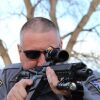January 12, 1998, is the day Kyle Dinkheller gave his life and, in doing so, saved countless other cops’ lives. The lessons learned from this tragedy have benefited law enforcement training for the past quarter-century and will continue to do so in perpetuity.
The events of that day
On January 12, 1998, Deputy Kyle Dinkheller pulled over 49-year-old Vietnam combat veteran Andrew Brannan in Lauren County, Georgia. Brannan exited his vehicle, as ordered, and started walking toward Dinkheller placing his hands in his pockets. Dinkheller, with his hand on his duty pistol, ordered Brannan to take his hands out of his pockets. That enraged Brannan. He began dancing maniacally and challenging Deputy Dinkheller to shoot him.
Dinkheller, his voice elevated, called for backup, which further enraged Brannan. He charged at Kyle who applied a few relatively ineffective baton strikes (mostly an equipment problem, in my opinion). Brannan retreated to his vehicle and retrieved and loaded a semiautomatic rifle.
Deputy Dinkheller called for assistance and retreated to the back of his patrol car, possibly to get his rifle from the trunk (his department either did not allow or at least facilitate, patrol rifles to be stored inside the vehicle’s cab). A gunfight ensued. Kyle was injured before shooting Brannan in the stomach. As is often the case with pistol gunshots below the sternum, Brannan was not immediately affected. He shot Kyle several more times, killing him.
Kyle Dinkheller was just 22 years old.
Background
Many trainers have used this incident in their training, but I don’t feel any of us have done so with either the reverence or the potential of which it’s worthy. A plethora of circumstances led to what happened that day and we must wring out every possible data point. Only then, can we be certain we’ve taken every step to ensure Kyle’s sacrifice is properly preparing our cops for a similar incident.
VirTra
My department has a VirTra 300 Firearms Training Simulator. We’ve integrated it into almost every aspect of our training to include de-escalation and even report writing. I recently spoke with Lon Bartel, director of training and curriculum at VirTra. He told me about a project they undertook involving the Dinkheller shooting.
If you’re familiar with VirTra, you know it’s not just a simulator. There are dozens of accredited training courses embedded in the system. The newest is the two-hour program simply called “My Story: Dinkheller.” It comes with VirTra’s standard annual update and is accredited for continuing education by the International Association of Directors of Law Enforcement Standards and Training. I’d like to touch on some of the learning points below.
Learning points
As with all the VirTra training programs, there is a video lesson attached to be used in conjunction with simulation. “Dinkheller” was not built merely with the goal of winning the encounter with hindsight knowledge, but instead, it breaks down the encounter with 50 different branching options.
Mindset
Kyle was a good marksman. He was a big, capable young man. He had all the tools needed to win a confrontation except mental preparedness.
Kyle’s father, Kirk Dinkheller, was involved in the creation of VirTra’s curriculum from the beginning. During an interview, he talks about what a decent man his son was and how unprepared he was for the confrontation with a trained, experienced killer. That had to be an incredibly difficult statement to make and it’s important we take it to heart.
Stress inoculation = resiliency
Resiliency is imperative for cops in real-world confrontations. Resiliency, however, is a diminishing human resource. Good times make weak people. The only tool we have as trainers to combat this phenomenon is stress inoculation. We have a camera in our VirTra room that allows the class to watch their fellow students’ successes and failures. In just five months, we see a substantial improvement in emotional strength in the recruits.
Tactics
The dispatcher can’t save you. You’re on your own. Gunfights happen in seconds. How many of those seconds should be spent on the radio to get backup that is minutes away? Broadcast briefly and sparingly. Spend your intellectual capital on the problem at hand.
Force
“Use enough force soon enough.” That’s a quote from my friend and renowned cop trainer, Chuck Haggard. Think about all the online videos of law enforcement encounters where things went terribly wrong. There is a time to retreat and there is a time to advance and engage. Knowing the difference comes from training.
Equipment
There was a time at my department when shotguns and rifles were not allowed to be stored in the cab of the patrol car. That policy is now recognized as inane and dangerous.
Tri-fold batons were an ill-conceived invention. Their compactness was a selling point, but when expanded, most of their weight is in the handle. Baton strikes are most effective when the brunt of the weight is at the striking end. We’ll never know if these equipment failures would have made a difference for Kyle, but there’s no doubt his odds would have improved.
Traffic stop tactics
Removing drivers from their vehicles during every traffic stop is unnecessary and dangerous. There is a time to remove vehicle occupants. That time is not on your first approach to the vehicle as was the policy in Dinkheller’s agency. Again, knowing when this is appropriate is a matter of training.
“Dinkheller” and VirTra
After reviewing the program and all branches of the VirTra “Dinkheller” program, we have another tool to prepare our folks for the increasing dangers they face. We have used this incident, not as a critique, but as an immeasurably expensive learning tool. We should thank VirTra for taking on this difficult project and passing it on to us as a no-cost update. But mostly, we should be thankful for Kyle Dinkheller.
For more information on the “Dinkheller” curriculum, click here.



